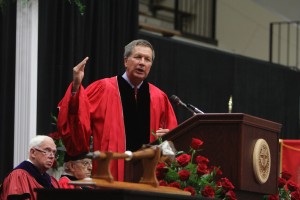
With Ohio’s gubernatorial election quickly approaching, and Governor John Kasich’s re-election a near certainty, what will his continued administration bring to Ohio’s education system and Youngstown State University in particular?
Most notable among the higher education policies Kasich enacted during his first term is performance-based funding, which ties public higher education financial backing to course completion and graduation rates. Prior to this, public colleges and universities were awarded state funds based on enrollment numbers.
Jack Fahey, vice president of student affairs at YSU, approves of performance-based funding and said the university was moving in that direction before Kasich’s policies were implemented.
“It’s been a good thing for students and a good thing for the state, as well as the university,” Fahey said.
Jeff Robinson, director of communications for the Ohio Board of Regents, said it was too early to tell whether or not the policy has been a success, but the policy hopes to align incentives with student success.
“The purpose is to have more students graduate and complete their degrees,” Robinson said.
There have been some concerns that tying funding to outcomes forces public institutions to narrow their open-door policies, which could have a negative impact on vulnerable students such as minorities, low-income students, women and aging students. Instead of helping these students graduate, universities will close their doors to them in order to increase graduation rates.
Teri Riley, the current interim provost and associate provost for academic administration, said performance-based funding played a role in the university’s decision to move away from open access.
“It’s caused us to re-examine our admission standards because one of the things that we want to make sure of is that we’re bringing in students who are going to be able to be successful,” Riley said.
Robinson said this is a result of the state’s “remediation free” standards. They found that the students who require remedial courses when they enter college are most likely to become discouraged and drop out. The state is putting programs in place to better prepare high school students for higher education.
“The idea is to have a greater number of students college-ready in their freshman year,” Robinson said.
Fahey said it is not beneficial for universities to accept students who can’t complete courses or stay on track to graduate.
“It doesn’t do a student any good to come to YSU, take out loans and not be successful,” Fahey said.
Riley said that Eastern Gateway Community College has made the transition from open access easier.
“One of the reasons why we were able to reevaluate our admissions practices is we now have Eastern Gateway,” Riley said. “So for a student who doesn’t meet the admissions qualifications to come here, we can now encourage them to attend Eastern Gateway, where a few years ago that wouldn’t have been a possibility for those students.”
But the model isn’t perfect.
“One of the problems is that if we improve in terms of our course completion rate and the graduation rates, it’s a fixed pie — so if we improve and everybody else is improving, we don’t get any more as a result of that,” Riley said.
Some have reported shrinking budget outlays to Ohio’s public universities during Kasich’s tenure, but that isn’t the case.
“Governor Kasich has actually allocated more money for higher education over the two-year biennium,” Robinson said.
The increase amounts to a few hundred dollars per student enrolled in Ohio’s higher education system. Specifically for YSU, this comes after 15 years in which the amount of money received from the state per full-time-equivalent student in inflation-adjusted dollars was cut nearly in half.
“It’s a matter of how the state is identifying its budgeting priorities,” Riley said. “We’re now at about 22 percent of our funding coming from the state, and the remainder of it is coming from tuition. When I first started at the university it was the exact opposite, we had about three-fourths of our revenue coming from the state and about one-fourth from tuition.”
The average full-time-equivalent student enrolled in Ohio’s public university system receives $4,182.71 from the state compared to approximately $3,600 at YSU. The average public university nationwide receives only 47 percent of its funding from tuition. At YSU, that number is 72 percent.
These trends began before Kasich was in office or performance-based funding took hold.
“We’re just in a changing climate, and we have to figure out how best we can adjust,” Riley said.
